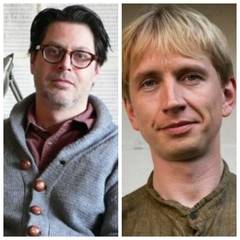|
Back
The Doors of Imperception New York
DiMenna Center
06/29/2023 -
Seong Ae Kim: Equal Magnitude (World Premiere/Ipse Commission)
Aruán Ortiz: Piedras de ida y vuelta (World Premiere/Ipse Commission)
Treya Nash: Tor (U.S. Premiere)
Ilari Kaila: Cameo
Charles Peck: Kindling
Joseph Di Ponio: DUST: Revealing/Concentrating (World Premiere)
Ensemble Ipse Core performers: Margaret Lancaster (Flutes), Christa Van Alstine (Clarinets), Esther Noh (Violin), Stephanie Griffin (Viola), Caleb van der Swaagh (Cello), Geoffrey Burleson (Piano), Colleen Bernstein (Percussion), Matt Ward (Conductor)

A. Ortiz/S. Ae Kim (© Ipse Ensemble)
“I haven’t understood a single bar of music in my life. But I have felt it.”
Igor Stravinsky
Pardon my ignorance, but Ensemble Ipse had been previously off my radar, although this group of artists has been performing since 2016. Even more important, they are devoted entirely to new works, having premiered 45 pieces, 15 of them commissioned by Ipse itself.
And the concert last night with six pieces from six unknown composers to me, from U.K., Cuba, Finland and America was a daunting, challenging. And yet this sextet, played by mainly the seven instrumentalists of the Ensemble, was a deliciously diverse one.
In fact, while I might not want to hear the music a second time, the initial experience was happily a curious one. For a good part of the evening, we may have heard too many fluttering strings, too many spaces between notes. But they all had their unhesitating destinations.
My only problem, as with so much music these days, is that the bijoux, the oh so clever and intricate and brilliant compositions, eschew–probably purposely–the all-so-essential mirific pull. Each of these six composers had set forth challenges, most had written their aims in the programs, and we sat for an abbreviated hearing (none over 20 minutes) for their unhesitating skills.
The opening, Seong Ae Kim’s Equal Magnitude, did indeed embody the title. It opened–as many of the works here–with a single note–with the entire Ensemble Ipse. Yet just as we thought it wasn’t going anywhere, Ms. Kim began to push and pull and open up the entire structure, as if a suction cup proceeded to lure the listener in before going back to the beginning. It was an engaging use of time and vibrations.
That fine Cuban‑born violist-composer Aruán Ortiz then presented Piedras de ida y vuelta (Stones back and forth), three movements of plucking and strumming with a leitmotif of piano in between each section.
Like the entire Ensemble Ipse’s work, conductor Matt Ward made every fragmentary note alive and trembling. Was Mr. Ortiz’ work moving? Perhaps not. But it was the music of a master craftsman.

T. Nash/C. Peck (© Ipse Ensemble)
British/North Carolinian composer Treya Nash described her Tor both as the German “door” and a “free‑standing rock formation...a mystical arcane.” Up which the composer climbed both as a girl and later returning. “They are gateways to both a primordial time and my own childhood.”
Extremely moving, and a “tor” into understanding her feeling. Of course the ascent might have foretold an Alpensymphonie redux. But no. These were not the steps, but the fractional spaces in between the steps.
In fact, so silently affecting was Tor that bone forgot the mechanisms, the spot‑on difficult timing coordination of the instruments and felt a non‑musical mystic intangible aura to her music.

J. Di Ponio/I. Kaila (© Ipse Ensemble)
Ilari Kaila’s Cameo had music unlike any other work here. It was absolutely retro. The Finnish-American composer, living now in Hong Kong, presented a gentle, tuneful, lilting, consonant (I heard not a single dissonance) and…er…(blush) toe-tapping. Instead of the full ensemble, flutist Margaret Lancaster, violist Stephanie Griffin and pianist Molly Morkoski enjoyed simply making music.
Starting with an amorphous folkish melody by Ms. Lancaster, the piece continued with other “tunes”, with a semi‑quodlibet, with unceasing rhythm. And a music which could have come from a 1940’s musical. If I didn’t catch Mr. Kaila’s inner meaning, sorry. And frankly, it had the rural dance‑like entertainment resembling the barn dances I heard many years ago in the villages of Karelia.
The following Kindling by Charles Peck was equally robust. The written explanation encompassed Jethro Tull, South Indian Karnatic music, and metrical motifs. All well and good. But Kindling was basically a tool for violinist Esther Noh to demonstrate her jazzy seemingly improvisational chops. Going back almost a century, Esther Noh’s playing was reminiscent of Stéphane Grappelli, the pre‑eminent jazz violinist (who often duetted with Jascha Heifetz). Whatever the structural intricacy, the “kindling” was frequently incandescent, thanks to her artistry.
The final work, Joseph Di Ponio’s DUST: Revealing/Concealing was cryptic in title and essence. The dust could have been “motes” or “molecules”. Almost parenthetical breaths from percussionist Colleen Bernstein, rustling on strings, the few notes from flute...a chance to hear musical flickers, fleeting flares, specks of notes.
Like Treya Nash’s Tor, one could never seize the moment. Yet one felt Mr. Di Ponios’ distinctive mind at work. Perhaps particles, perhaps electrons, always amorphous, always tantalizing.
Harry Rolnick
|